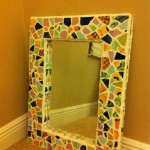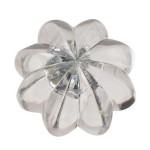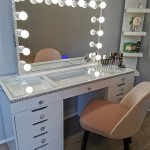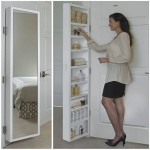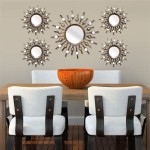```html
How To Make A Mirror Ball Out Of Foil
Creating a dazzling mirror ball, also known as a disco ball, using aluminum foil is a cost-effective and engaging project. This method provides a lightweight alternative to traditional glass mirror balls, making it safer and easier to hang. The process, while requiring patience, yields a reflective surface that effectively scatters light, creating a festive atmosphere. This article details the sequential steps to construct a sturdy and visually appealing mirror ball using readily available materials.
Materials Required
The first step involves gathering the necessary materials. This ensures a smooth and uninterrupted construction process. Acquiring high-quality materials, even for this DIY project, contributes to the overall durability and aesthetic appeal of the finished mirror ball. A comprehensive list of materials includes:
- A Styrofoam Ball: This serves as the core structure of the mirror ball. The size of the ball determines the final dimensions of the project. A dense styrofoam ball is preferable as it holds its shape better during the application of foil.
- Aluminum Foil: A significant amount of aluminum foil is needed to cover the entire surface area of the styrofoam ball. Heavy-duty aluminum foil is recommended as it is less prone to tearing and provides a smoother reflective surface. Consider several rolls depending on the size of the ball.
- Craft Glue: A strong, quick-drying craft glue is essential for adhering the aluminum foil pieces to the styrofoam ball. Ensure the glue is compatible with styrofoam to prevent it from dissolving or damaging the core. Hot glue can also be used, but requires caution due to the risk of burning.
- Scissors or Craft Knife: These tools are needed for cutting the aluminum foil into small, manageable pieces. A sharp pair of scissors or a craft knife will facilitate precise and clean cuts.
- Hanging Hardware: A swivel hook or eye bolt and strong string, wire, or chain are necessary for suspending the finished mirror ball. The chosen hardware should be capable of supporting the weight of the ball without failing.
- Pencil or Marker: This is used for marking the placement of the hanging hardware on the styrofoam ball. Accuracy in marking ensures the ball hangs evenly.
- Optional: Protective Gloves: These can protect hands from glue and sharp edges, enhancing comfort during the project.
Preparing the Styrofoam Ball and Attaching Hanging Hardware
The preparation stage is crucial for ensuring the structural integrity and aesthetic presentation of the final product. Beginning with the styrofoam ball, locate the intended top point for hanging. This step requires careful consideration to maintain balance once the mirror ball is suspended.
Using a pencil or marker, mark the selected point clearly. The depth of the mark should correspond to the length of the screw thread on your chosen hanging hardware. If using an eye bolt, carefully screw it into the styrofoam ball at the marked location. Ensure the eye bolt is securely embedded but avoid forcing it, as this could damage the styrofoam. For a swivel hook, the same process applies: screw it firmly into the styrofoam at the marked point. If the styrofoam is too soft and the hardware doesn't hold securely, a small amount of craft glue can be applied to the threads before inserting the hardware. Allow the glue to dry completely before proceeding.
After attaching the hanging hardware, inspect the connection for stability. The hardware should be firmly anchored in the styrofoam to prevent it from detaching once the ball is covered in foil. A weak connection at this stage could result in the mirror ball falling after completion, potentially causing damage or injury.
The final aspect of preparation involves ensuring the styrofoam surface is clean and free of any debris. This ensures optimal adhesion of the aluminum foil. Wipe the surface with a clean, dry cloth to remove any dust or dirt particles. This step enhances the aesthetic quality of the mirror ball by promoting a smoother and more reflective surface.
Applying the Aluminum Foil
The application of aluminum foil requires a methodical approach to achieve a uniformly reflective surface. The key to creating a convincing mirror ball effect lies in the precise cutting and careful adherence of individual foil pieces.
Begin by cutting the aluminum foil into small, roughly square pieces. The size of these pieces will influence the overall texture of the mirror ball. Smaller pieces create a more faceted, mosaic-like appearance, while larger pieces offer a smoother, less fragmented surface. A recommended starting size is approximately one to two inches square, though experimentation is encouraged to achieve the desired visual effect.
Once a sufficient quantity of foil pieces has been cut, begin applying them to the styrofoam ball. Apply a small amount of craft glue to the back of each foil piece, ensuring even coverage. Then, carefully press the foil piece onto the styrofoam surface. Overlap each piece slightly with the adjacent pieces. This overlapping ensures complete coverage of the styrofoam ball and prevents any of the core material from being visible. The overlapping also contributes to the structural integrity of the foil layer.
Continue this process, systematically covering the entire surface of the styrofoam ball. It is essential to maintain a consistent pattern of overlapping foil pieces. As the foil is applied, gently smooth out any wrinkles or creases. This process enhances the reflective properties of the foil and creates a more uniform appearance. However, some small wrinkles and imperfections are unavoidable and contribute to the characteristic shimmering effect of a mirror ball.
Pay particular attention to the area around the hanging hardware. Ensure that the foil is neatly trimmed and securely adhered around the base of the eye bolt or swivel hook. Avoid obstructing the hardware, as this will interfere with the ball's ability to rotate freely. The area surrounding the hanging point should be reinforced with additional foil pieces to provide enhanced structural support.
After covering the entire ball, allow the glue to dry completely. The drying time will vary depending on the type of glue used and the ambient humidity. Consult the glue manufacturer's instructions for specific drying times. Once the glue has dried, inspect the mirror ball for any gaps or loose foil pieces. Address any imperfections by applying additional glue and foil as needed. This quality control step guarantees the long-term durability and aesthetic appeal of the finished product.
Following the complete drying process, carefully clean the foil surface with a soft cloth to remove any residual glue or fingerprints. This final polishing enhances the reflectivity of the foil and creates a more vibrant, eye-catching effect. The mirror ball is now ready for hanging and display.
```
How To Make Mirror Polished Japanese Foil Ball Easy Diy

Diy Aluminum Foil Mirror Ball Challenge How To Make The Japanese Polishing

Diy Mirror Polished Japanese Aluminum Foil Ball

Mirror Polished Aluminium Foil Ball Make It Very Easy At Home A New Method To Steel Diy Aluminum Crafts How

How To Make A Foil Ball Polished What S Inside The

How To Make A Foil Ball Polished What S Inside The

Easy Disco Ball Craft For Kids New Year S Eve Activities Project Whim

Diy Japanese Aluminum Foil Ball 4 Steps Instructables

Diy Aluminum Foil Ball Japanese Challenge Awesome Life S által Crafts Mirror Art

Easy Disco Ball Craft For Kids New Year S Eve Activities Project Whim

